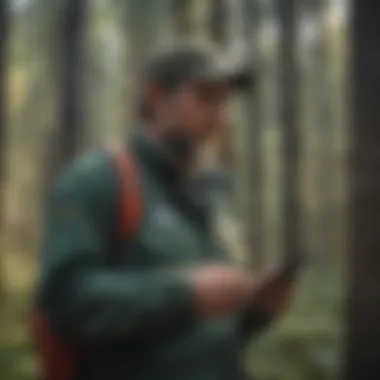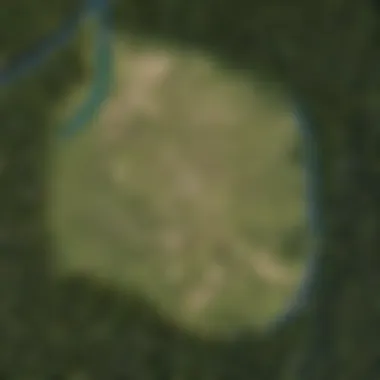Harnessing GPS Coordinates for Effective Woodland Stewardship


Intro
In today’s rapidly changing world, the importance of woodland stewardship cannot be overstated. Accurate mapping and understanding of forested areas are essential for effective management and conservation. The integration of GPS coordinates readers has revolutionized forestry practices, allowing professionals to monitor ecosystems, plan sustainable practices, and enhance biodiversity. This article aims to elucidate the numerous dimensions of GPS technologies and their impactful role in woodland stewardship, focusing on how these tools provide crucial data for ecological and management decisions.
Understanding Woodland Ecosystems
Woodland ecosystems are dynamic environments that support a myriad of life forms. They include not only trees but also shrubs, fungi, and various animal species. Understanding these systems is vital for effective stewardship.
Importance of Biodiversity in Forests
Biodiversity plays a critical role in the resilience and health of forests. It ensures complex interactions between species, which can enhance productivity and stability. Rich biodiversity can help forests withstand diseases, pests, and climatic variations.
The conservation of diverse species is necessary:
- To maintain ecosystem services such as clean air and water.
- To support recreational activities and tourism.
- To preserve genetic resources for future research and applications.
Role of Forests in Climate Regulation
Forests act as significant carbon sinks, absorbing carbon dioxide from the atmosphere and releasing oxygen. They play an integral role in climate regulation. Forests help to moderate temperatures and purify the air, which is vital as climate change continues to progress. Effective forest management through confident GPS coordinates can lead to better understanding and interventions that mitigate climate impact.
Sustainable Forestry Practices
Sustainable forestry balances the need for economic benefits from forest resources with environmental and social needs. It promotes the idea of using forests in a way that they can regenerate and be available for future generations.
Principles of Sustainable Forestry
The principles of sustainable forestry include:
- Long-term planning: Focused on the future health of forests rather than short-term gains.
- Ecosystem-based management: Takes into account the entire ecosystem, understanding that each element plays a role.
- Community involvement: Engaging local communities in decision-making processes.
Case Studies of Successful Implementations
Regions around the world have successfully implemented sustainable forestry principles. For example, the Forest Stewardship Council certification has established standards that promote responsible forest management. Studies show that certified forests have better biodiversity outcomes. Access to these outcomes can be enhanced via GPS technology, giving real-time data on forestry trends and health.
Woodland Stewardship Techniques
Woodland stewardship involves active management and care for forest ecosystems. It requires an understanding of various techniques that promote sustainability.
Forest Management Plans
A well-formed forest management plan is essential. It should:
- Address specific goals and objectives for the forest.
- Include assessment of forest conditions, species health, and resources.
- Implement specific actions based on thorough research.
Conservation Strategies
Effective conservation strategies are crucial for the sustainability of woodlands. These strategies may involve:
- Protecting key habitats from human encroachment.
- Managing invasive species that threaten native biodiversity.
- Restoring degraded areas to boost ecological health.
"Sustainable forestry is more than just a practice; it’s a commitment to the future of our planet."
Prolusion to GPS Technology
The integration of GPS technology has become a cornerstone in the field of woodland stewardship. Understanding how Global Positioning System (GPS) coordinates operate is essential for forestry professionals. Accurate location data is critical for effective land management, enabling better decision-making and resource allocation. This section aims to inform readers about the historical background and fundamental principles governing GPS technology, setting the stage for its application in forestry practices.
History of GPS Development
The GPS technology has its roots in military applications, specifically developed by the United States Department of Defense in the 1970s. Initially intended for navigational purposes in defense operations, GPS expanded to civilian usage in the 1980s. Several satellites were launched into orbit, transmitting signals that enable precise positioning on the Earth’s surface. Over time, the technology improved, increasing accuracy and reliability.


The transition from military to civilian use marked a significant evolution in GPS technology. In 2000, the selective availability feature was removed, allowing civilians to access the full potential of GPS signals. This opened up new avenues in various fields, including agriculture, transportation, and forestry. As a result, GPS became an invaluable tool for tracking and managing natural resources, helping professionals make informed decisions.
Basic Principles of GPS Functionality
At the core of GPS functionality lie the concepts of triangulation and satellite networks. The system operates by using signals broadcasted from a constellation of satellites orbiting Earth. A GPS receiver calculates its position by measuring the time it takes for signals from at least four satellites to reach it. The key steps involved are as follows:
- Signal Reception: Each satellite sends out messages indicating its position and the precise time the message was transmitted.
- Distance Calculation: The receiver calculates the distance to each satellite based on the time delay between transmission and reception.
- Position Fix: Using the distance measurements, the receiver employs trilateration to pinpoint its exact location on Earth.
This process allows a GPS reader to provide accurate coordinates in terms of latitude and longitude. The reliability of GPS data makes it a powerful tool for forestry, facilitating tasks such as mapping boundaries, tracking wildlife, and conducting environmental assessments.
Understanding GPS technology is not just about knowing how it works; it is about leveraging its capabilities to enhance forest management and environmental conservation.
What is a GPS Coordinates Reader?
In the field of woodland stewardship, understanding what a GPS coordinates reader is fundamental. These devices play a crucial role in measuring and interpreting geographical information. By transforming complex data into actionable insights, GPS readers facilitate effective forest management. They provide essential information for planning, tracking, and conserving forested areas. Utilizing these tools allows professionals to make data-driven decisions, ultimately leading to sustainable management of natural resources.
Defining GPS Coordinates
GPS coordinates denote a specific location on the Earth's surface. They are represented as pairs of numbers: latitude and longitude. Latitude indicates the north-south position, while longitude specifies the east-west location. This system enables precise identification of locations, which is vital for forestry applications. Accurate GPS coordinates provide a universal reference that helps in tracking changes in forest demographics, assessing timber resources, and planning interventions. The significance of these coordinates cannot be overstated, as they are integral to various management activities, such as habitat restoration and biodiversity conservation.
Types of GPS Readers
GPS readers come in various forms, each suited for specific applications. Common types include:
- Handheld GPS devices: Portable units designed for outdoor use. They offer basic navigation functions and are often used by forest managers for field assessments.
- Smartphone GPS applications: Utilize built-in GPS technology in smartphones. They provide convenience and can integrate additional features, such as mapping software.
- Dedicated GPS tracking systems: Typically employed in forestry vehicles, these systems enable continuous monitoring of equipment and operator activities.
- Geographic Information System (GIS) software: Advanced tools used to analyze and visualize spatial data. These systems allow for comprehensive mapping and data integration, aiding in strategic planning.
Each type of GPS reader has its advantages and drawbacks; thus, selecting the right tool depends on specific project needs and operational contexts. Proper utilization of these devices can significantly enhance forest management efficiency.
Functionalities of GPS Coordinates Readers
GPS coordinates readers possess several functionalities that are vital to effective woodland stewardship. Their capabilities encompass precise location tracking, data collection, and integration with various management systems. These functions are not only beneficial for mapping and navigation purposes but also enhance decision-making in forestry practices.
One key function is the accurate capture of geographical data. GPS readers utilize satellites to triangulate their position on Earth. This process allows for the creation of accurate maps that illustrate various forest components, such as tree density, species distributions, and land boundaries. The precision in data collection enables forestry professionals to make informed decisions and implement targeted conservation strategies.
Beyond just capturing location data, these devices can also record additional information. For example, some GPS readers come equipped with sensors that measure altitude, temperature, and humidity. This enriched data collection can guide sustainable forest management by aligning ecological factors with physical locations on the landscape.
Important Note: The integration of different data types can enhance the understanding of forest dynamics, leading to better conservation outcomes.
The functionalities of GPS coordinates readers extend into several domains, including inventory management, land-use planning, and habitat mapping. When forestry professionals select the correct tools, they gain access to vital functionalities tailored for their specific needs. These tools can support habitat assessment, monitoring of forest health, and tracking changes over time—essential components for any successful woodland stewardship strategy.
How GPS Readers Capture Data
GPS readers function primarily through the reception of signals sent from satellites orbiting the Earth. The three main steps in capturing data can be summarized as follows:
- Signal Reception: The GPS receiver picks up signals from multiple satellites. Each satellite sends time-stamped signals that indicate its exact position at that moment.
- Triangulation: By analyzing the time it takes for the signals to reach the reader, the device calculates its own position on the Earth. This requires data from at least three satellites for two-dimensional positioning, and four for three-dimensional positioning, which includes altitude.
- Data Integration: Once the location is determined, the GPS system can integrate this information with other geospatial data, enabling further analysis and visualization in various software applications.
This method of data capture is not just limited to positioning. Many modern GPS readers can also attach to mobile devices or computers, allowing for real-time data logging and mapping. This feature is especially useful in fields like forestry, where immediate access to data can influence on-site management decisions.
Data Accuracy and Limitations
While GPS technology is a powerful tool for woodland stewardship, it is not without its limitations. The accuracy of GPS data can be influenced by several factors:
- Satellite Geometry: The position of satellites relative to the GPS reader can affect accuracy. A clear view of the sky generally results in better precision.
- Atmospheric Conditions: Weather conditions can distort signals, causing errors in data capture. Rain, fog, or solar activity may interfere with satellite signals.
- Obstructions: Trees, buildings, and other structures can block signals, creating inaccuracies in location data. Dense forests can particularly complicate signal reception.
Despite these challenges, it is possible to enhance data accuracy through techniques such as:
- Differential GPS (DGPS): This method uses a network of fixed ground-based reference stations to correct GPS signal errors, achieving higher accuracy.
- Post-Processing Techniques: Collecting data and processing it later can enable adjustments for known inaccuracies, improving the overall reliability of the dataset.
Understanding these factors is critical for forestry professionals who rely on GPS coordinates. Awareness of the limitations will inform better practices when utilizing these tools in woodland stewardship and conservation efforts.


Application of GPS Coordinates in Forestry
The application of GPS coordinates in forestry plays a critical role in enhancing the efficiency and effectiveness of woodland stewardship. GPS technology fundamentally changes how forestry professionals approach tasks like mapping, data collection, and resource management. Accurate GPS coordinates help in resource allocation, monitoring tree growth, and tracking wildlife. These coordinates facilitate better decision-making, which leads to sustainable practices in forest management. The ability to pinpoint precise locations is vital for many aspects of forestry, including conservation efforts and compliance with environmental regulations.
Importance of Mapping and Tracking
Mapping and tracking are essential processes in forestry. Utilizing GPS coordinates allows for the creation of detailed maps that represent various forest features. This mapping can include tree species distribution, soil types, and water bodies. With these maps, forestry professionals can visualize the landscape and plan accordingly.
Tracking involves monitoring changes over time. For instance, forestry managers can observe growth patterns and assess the health of trees. They can also track changes caused by environmental factors, such as pest infestations or diseases. Using GPS coordinates, it becomes easier to identify areas that require intervention. The benefits include:
- Data-Driven Decisions: Accurate data helps forestry professionals make informed decisions.
- Resource Management: Proper tracking ensures resources are allocated where they are needed the most.
- Enhanced Conservation Efforts: Mapping and tracking can aid in identifying habitats that require protection.
"GPS technology enhances forestry by allowing precise mapping and tracking of woodland ecosystems, leading to more sustainable management practices."
Enhancing Forest Management Practices
The incorporation of GPS coordinates readers in forest management practices can significantly improve overall outcomes. By providing accurate location data, forestry professionals can enhance their strategies in various areas.
One key benefit is the efficiency gained in planning and executing forestry operations. For instance, when conducting timber assessments or inventories, having precise GPS coordinates helps in placing markers and dividing land into manageable sections. This structured approach leads to a more organized workflow, reducing time spent on locating specific areas.
Moreover, GPS data can facilitate better communication among teams working in the field. A common reference point minimizes misunderstandings and ensures everyone is aligned on project objectives. Additionally, seamless integration with Geographic Information Systems (GIS) enables professionals to analyze complex data sets effectively.
Case Studies of GPS in Woodland Conservation
The application of GPS technology in woodland conservation has produced significant results across various geographical contexts. Examining specific case studies allows professionals to understand both the effective implementations and the pitfalls encountered along the way. Learning from these instances is important because they provide grounded insights into the practical utility of GPS coordinates readers in forestry. Through analyzing real-world applications, we can highlight the benefits of accurate location data and its impact on environmental stewardship. Moreover, these case studies serve as a framework to guide future efforts in woodland management.
Successful Implementations Globally
Numerous successful examples of GPS technology in woodland conservation demonstrate its advantages in preserving forest ecosystems. These implementations have primarily focused on tracking wildlife, mapping resources, and monitoring environmental changes.
- Wildlife Tracking in Yellowstone National Park: The GPS collaring project integrated GPS coordinates to monitor the movements of wolf packs. This data allowed researchers to assess the health of the ecosystem and implement necessary management strategies. The effectiveness of this project showcases the utility of GPS in ecological research and conservation efforts.
- Forest Inventory in Danum Valley, Malaysia: Here, researchers utilized handheld GPS devices to locate and catalog trees in an intricate rainforest ecosystem. The data collected has enabled better resource management decisions while also addressing biodiversity loss in the area.
These examples illuminate how GPS technology can greatly enhance both the efficiency and effectiveness of conservation efforts. The ability to gather accurate and real-time data significantly supports informed decision-making.
Lessons Learned from Failures
Not all GPS implementations in woodland conservation have been successful. Examining failures can provide vital lessons on what to avoid or improve upon in future endeavors.
- Data Overload from the Amazon Rainforest Project: In attempting to gather too much data too quickly, this project faced logistical challenges. The excess of information became hard to process, nullifying the potential benefits of real-time tracking and monitoring. A more focused approach could have yielded better results.
- Inaccurate Data from Urban Forest Studies: In some urban forestry studies, poor signal reception due to dense building structures led to unreliable data. This situation shows the importance of understanding the environmental conditions where GPS tools will be employed. Adequate planning can help mitigate such challenges.
Through these lessons, professionals can learn to tailor their GPS applications to specific environments and project goals. Understanding both the successful and less successful implementations can inform best practices for utilizing GPS coordinates readers effectively.
"Learning from practical experiences—successes and failures—enhances our ability to steward woodland resources with precision and responsibility."
Best Practices for Utilizing GPS Coordinates Readers
Utilizing GPS coordinates readers effectively is vital for maximizing their benefits in woodland stewardship. Given the intricate relationship between data accuracy, user training, and the specific requirements of forestry management, adopting best practices becomes crucial. Proper practices not only enhance operational efficiency but also ensure that the data collected leads to informed decision-making in forest management. This section outlines essential elements regarding the selection of GPS tools and the necessary training for users, aiming to foster a deeper understanding of these practices.
Selecting the Right GPS Tools
Choosing suitable GPS reading tools is a foundational step in any forest management effort. With a variety of models available, it is important to evaluate several factors before making a decision. Adequate research can lead to the selection of tools that match both the specific tasks at hand and the unique conditions of the woodland ecosystem.
When considering GPS tools, factors to keep in mind include:
- Accuracy and Precision: Higher accuracy is often required for detailed surveying and management tasks. Look for devices with advanced antennas or correction signal capabilities.
- Durability: The woodland environment can be harsh. Selecting rugged devices that withstand weather extremes is essential for longevity.
- User Interface: An intuitive interface can significantly reduce the learning curve for users, making it easier to gather data efficiently.
- Battery Life: Long-lasting batteries are crucial, especially for extended fieldwork. Evaluate models that offer quick charging or alternative powering options.
Additionally, consider tools that integrate seamlessly with other forest management software. This integration can enhance data analysis capabilities and streamline workflow processes.
Training and Skill Development for Users


Training is another critical aspect of using GPS coordinates readers effectively. Even the best tools can't produce results without skilled users. This training should cover the technical aspects of operating the devices and interpreting the data accurately.
Key areas for training include:
- Technical Proficiency: Users should understand how to operate GPS devices effectively. Training sessions should cover all functionalities, settings, and potential troubleshooting steps.
- Data Collection Techniques: It is important for users to learn proper data collection methods. Improper techniques can lead to inaccurate data, undermining the entire effort.
- Interpretation of Data: A proficient user should be able to interpret GPS data accurately. Training should include exercises in analyzing the data to make informed decisions.
- Updates on Technology: GPS technology is always evolving. Continuous education and periodic refresher courses will help users stay updated on the latest features and functionalities of their GPS tools.
"Investing time in training users can have long-term benefits, ensuring that GPS technology is used to its fullest potential."
By focusing on these best practices, forestry professionals can optimize their use of GPS coordinates readers for woodland stewardship. This approach not only enhances the overall efficiency of forest management activities but also supports conservation efforts grounded in accurate and reliable data.
Future Trends in GPS Technology
Future trends in GPS technology hold significant importance for woodland stewardship. As forestry professionals and academics seek more efficient and effective ways to manage forest resources, it is crucial to understand how advancements in GPS can facilitate these goals. The potential of enhanced accuracy and better accessibility of GPS data can profoundly impact decision-making processes in woodland management.
Advancements in Accuracy and Accessibility
Advancements in GPS technology are continually improving the accuracy of location data. As devices incorporate better satellite signals and more sophisticated algorithms, GPS accuracy can reach within a few centimeters. This precision can be vital for tasks such as tree planting, where pinpointing exact locations can determine survival rates of seedlings. For instance, techniques like Real-Time Kinematic (RTK) positioning provide millimeter-level accuracy, which can aid in informative land-use planning and site inventory.
Furthermore, accessibility to GPS technology is expanding. Affordable GPS devices are becoming readily available, allowing even small stewardship organizations to benefit from the technology. Mobile applications also enable forest managers to use GPS capabilities on their smartphones or tablets. With advancements in network coverage, GPS functionalities can be utilized in even the most remote areas, making it easier for users to gather data without the constraint of location.
Integration with Other Technologies
GPS technology is increasingly being integrated with other technologies to enhance its utility in woodland stewardship. The combination of drones and GPS serves as a foremost example. Drones equipped with GPS can conduct aerial surveys of vast forest areas, collecting essential data on forest health, diversity, and structure.
Other technological integrations also include Geographic Information Systems (GIS). By combining GPS data with GIS, forestry professionals can create detailed models of forest landscapes. This integration allows for better data visualization, analysis, and informed management decisions.
"The intersection of GPS and GIS creates a powerful toolset for environmental management, enabling the comprehensive study of forestry patterns and trends."
Moreover, the advent of the Internet of Things (IoT) enables real-time data collection from forest sensors. These devices can transmit GPS coordinates alongside other environmental data, facilitating dynamic monitoring and quicker response strategies to ecological changes.
Challenges and Considerations
In the context of GPS coordinates readers, understanding the challenges and considerations is vital for effective woodland stewardship. Environmental settings, technological limitations, and ethical uses of gathered data all play a crucial role in navigating the complex landscape of GPS technology in forestry practices. Addressing these challenges not only enhances the effectiveness of forest management but also ensures responsible usage of data collected.
Environmental Factors Impacting GPS Signals
GPS technology relies heavily on signal reception, which can be adversely affected by environmental factors. Physical elements like dense tree canopies, topographical features, and atmospheric conditions can disrupt the satellite signals required for location accuracy. For instance,
- Canopy cover: In heavily forested areas, signals can be blocked or weakened by the leaves and branches, leading to inaccurate location data.
- Terrain: Mountains or deep ravines can streamline signal reception, causing errors in coordinate readings.
- Atmospherics: Weather phenomena such as heavy rain or storms can introduce delays in signal transmission.
These factors underscore the need for forestry professionals to consider the physical environment when employing GPS coordinates readers for woodland management. Understanding these challenges aids in selecting appropriate tools and planning more effective data collection strategies.
Ethical Considerations in Data Usage
With the increasing capabilities of GPS technology, ethical concerns regarding the use of location data have emerged. The collection of geographical information must be approached with caution to respect privacy and data integrity. Several key considerations include:
- User Consent: It is essential to obtain permission from individuals whose data may be collected, maintaining transparency about its intended usage.
- Data Security: Protecting gathered data from unauthorized access is paramount. Forestry professionals should implement robust security measures to safeguard sensitive information.
- Impact on Communities: The usage of GPS data can influence local communities, so awareness of local laws and customs is necessary.
Understanding these ethical considerations is important for forestry professionals, ensuring responsible and respectful practices in the usage of GPS coordinates.
"Effective woodland stewardship involves not just technology, but also a commitment to ethical usage and environmental awareness."
The conversation surrounding GPS coordinates readers and their role in forestry practices is rich with complexities. By addressing environmental challenges and adhering to ethical guidelines, professionals can better harness the capabilities of GPS technology while promoting sustainable and responsible woodland management.
Finale
Recap of Key Points
- GPS Technology Significance: GPS technology is integral for forestry, allowing for the accurate mapping of forested areas. This aspect helps in planning efforts and making informed decisions.
- Functionalities of GPS Readers: Different types of GPS coordinates readers provide various functionalities, from basic location tracking to more complex data analysis and integration with other technology.
- Applications in Forestry: Utilizing GPS coordinates in woodland stewardship enhances tracking and monitoring forest health. This leads to improvements in resource allocation and effectiveness of conservation strategies.
- Challenges and Considerations: The challenges associated with GPS usage, such as environmental signal disturbances and ethical considerations for data handling, also play a significant role in how these tools are applied in the field.
The Future of GPS in Woodland Management
Looking ahead, GPS technology will likely continue evolving, leading to more precise tools with better integration capabilities. Emerging advancements may enhance both accuracy and ease of accessibility. Moreover, the combination of GPS data with remote sensing technologies could provide a holistic view of forest health and change dynamics.
The future may also open discussions about more standardized practices for data sharing and sustainability in the context of environmental ethics. As GPS becomes more integrated into forestry practices, forest professionals must remain vigilant concerning privacy and data usage to ensure that the information gathered serves both conservation and community needs.







